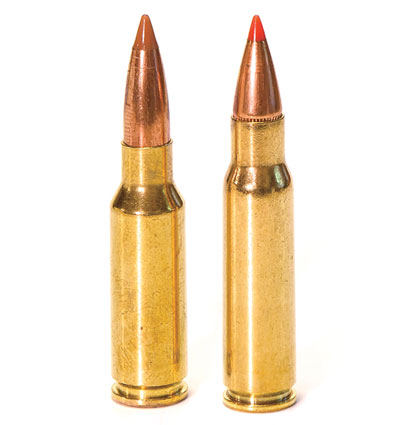
Football fans know the term wildcat: It's used to describe a somewhat unorthodox formation on offense. If you're a young man in college playing the field, it's used to describe some of the ladies you meet. For shooters, you could argue the term is not completely dissimilar, even though it describes something which has nothing to do with football or dating.
I have no idea who coined the term wildcat with regard to metallic cartridges. According to Frank Barnes, author of "Cartridges of the World," which was first published in 1965, he had no idea either. The conventionally accepted definition of a wildcat cartridge would be any Sporting Arms and Ammunition Manufacturer's Institute (SAAMI)-approved cartridge, the shape of which has been modified.
Actually, every cartridge started out as a wildcat— a new idea based on something else—but traditionally, the term refers to the modification of a commercial cartridge by a handloader who is not working for a major manufacturer. Probably the most famous of all wildcats is the .257 Roberts, developed by gun writer Ned Roberts in the late 1920s. In 1934, a very similar version of Roberts' wildcat was adopted by Remington and given his name.
How does commercial adoption of a wildcat occur? The cartridge becomes so popular, a major manufacturer realizes money can be made by loading it. The manufacturer then submits cartridge drawings along with load and pressure data to SAAMI for standardization, and voila—a commercial round is born. A recent example of this would be the .300 AAC Blackout, legitimized by Advanced Armament Corporation and Remington. This cartridge had been around for many years in a very similar form called the .300 Whisper—a proprietary wildcat—developed by renowned wildcatter J.D. Jones.
Why would anyone want to develop a wildcat? Generally, it's the quest for more, or sometimes less, velocity, but other factors influence development. A new law in Indiana, which allows .35- or larger-caliber cartridges to be used in rifles for deer hunting—as long as the cartridge case is no longer than 1.80 inches—has spawned a wide variety of wildcats like the .358 Gremlin, which is based on the 6.5 Grendel cartridge. Ironically, at the time of the Gremlin's conception, the 6.5 Grendel was a wildcat, too (the Grendel has since been adopted by SAAMI). Hoosiers, once limited to shotguns, can now deer hunt with an AR-15—the platform wildcatters had in mind when engineering the Gremlin.
Some wildcatters have visions of fame and fortune. This rarely happens. Even if a major manufacturer adopts a cartridge you design, don't expect it to pay you anything. At best, your name might be linked to its development. Or, if you happen to be a famous gun writer (and I'm not sure if there even is such a thing anymore) like Roberts or Col. Townsend Whelen, there's a chance your name will be on the cartridge headstamp. That's something you could brag about, I guess.
This is precisely why some wildcatters keep their cartridge proprietary. They want some recognition and payback for all the hard work they've invested. They'll sell you cases, dies, reamers and so forth, but the fact remains: a cartridge must go mainstream and see adoption by SAAMI and major manufacturers before it will ever truly make money or be historically important. While some might consider it genius, altering the shape of a brass cartridge case is not all that difficult or groundbreaking. Creating one everyone wants, now that is something.
I spent the last year editing the new edition of "Cartridges of the World," and part of my job was finding new and previously unlisted wildcat, proprietary and factory cartridges for inclusion. Many of the cartridges I uncovered, like the .358 Gremlin and the .25-45 Sharps, were specifically wildcatted for the AR-15 platform.
The development of a wildcat cartridge starts with an idea, but its realization is made possible by reamers. You see, for every cartridge—wildcat, proprietary, or factory—you need reamers, several reamers. You'll need a chamber reamer to cut the chamber in the barrel. You'll also need reamers for reloading dies. And, you'll need Go/No-Go gauges so proper headspace on firearms can be set.
Dave Kiff at Pacific Tool & Gauge is probably the first stop if you want to make a wildcat. He will know if it's already been done, if it can be done and how to do it. The company is the leading source for cartridge reamers and gauges for wildcatters and major manufacturers. Kiff recently helped American ballistician Jimmy Sloan develop a cartridge many consider superior to the .338 Lapua Mag. The new cartridge performed so well, Norma legitimized it as the .338 Norma Mag. Kiff also helped me put two wildcats together.
One problem with wildcat development is predicting or measuring pressure. Garage wildcatters often preach the velocity virtues of their creation, but have no idea what pressures it's generating. There are some do-it-yourself pressure-measuring tools, but the best option is a ballistics laboratory. This is precisely what fellow hillbilly Mike Cyrus of Lehigh Defense did when he developed the .500 Cyrus. He purchased a pressure barrel and commissioned the experts at Hornady to safely sort it all out for him.
About every metallic cartridge you can imagine has already been created. Still, every year we see a new spin offering more velocity or one that is more compact and presumably more accurate. If you think you have the next, best idea, go for it. Maybe your wildcat will make it in the next edition of "Cartridges of the World." Maybe some manufacturer will start loading it and even building rifles for it. Just don't expect to get rich.





































